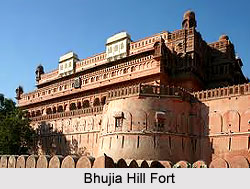 Bhujia Fort also known as Bhujiya Fort is located in the town of Bhuj of Kutch in the Indian state of Gujarat. The Fort is built on a hill overlooking the town of Bhuj. Bhujia Fort offers a panoramic view of the Bhuj city. The Bhujia hill on which this fort stands gets its name from this snake deity Bhujanga.
Bhujia Fort also known as Bhujiya Fort is located in the town of Bhuj of Kutch in the Indian state of Gujarat. The Fort is built on a hill overlooking the town of Bhuj. Bhujia Fort offers a panoramic view of the Bhuj city. The Bhujia hill on which this fort stands gets its name from this snake deity Bhujanga.
History of Bhujia Hill Fort
According to history the Bhujia Fort was constructed on the Bhujia by Jadeja Chief, Rao Godaji for the security of Bhuj. The construction of Bhujia fort was started by Rao Godaji that continued from 1715-1718. It was built to secure the town. However, the major work was completed under the reign of his son, Maharao Deshalji I in 1718-1741. Devakaran Sheth, Diwan of Kutch during Rao Deshalji I took the lead in fortifying the hill. Since its construction the fort has stood against six major battles which were fought in years 1700-1800 AD. The battles were fought between Rajput rulers of Kutch, the Muslim raiders from Sind and Mughal rulers of Gujarat.
The Bhujia Hill Fort witnessed the first major battle between Deshalji I and Sher Buland Khan.
The battle was fought during early part of reign of Deshalji I, when Sher Buland Khan, who was Mughal Viceroy of Gujarat, invaded Kutch. At that point the army of Kutch was in an unstable condition. The Bhujia Fort was thus opened by a group of Naga Bawas.
The group on the pretext of visiting Nag temple for worship joined in the battle against Sher Buland Khan`s army. Since that day Naga Bawa along with their leader got a prominent place. In their honour a procession is held on Nag Panchmi day every year. The Bhujia Fort since then has been under occupation of military personal.
Temple of Bhujanga Naga
At one corner of the Bhujia Hill fort a small square tower has been constructed that is dedicated to the `Bhujang Nag` also known as the snake god. According to folk fare snake god is said to be the brother of `Sheshnag` who is the Lord of the nether world i.e. `Patal`. The Snake Temple was built during the time of fortification of hill by Deshalji`s reign. They proved to be victorious in the battle with the help of Naga Sadhus. These Naga Sadhus deeply worshipped the Snake god. Thus Deshalji, the ruler of Kutch in honour of the Sadhus and the Snake God built a Chhatri over the temple in 1723. To commemorate this incidence an annual fair is organised on the fort-hill on the Nag Panchami day in Shraavana month as per Hindu calendar.
Since Independence the Bhujia Hill fort has been under the control of Indian Army. Entry inside the fort is strictly prohibited except on the day of Nag Panchami fair, held once in a year. An army depot on the Bhujiya hill fort stores tanks, guns, mortar and high explosives.



















